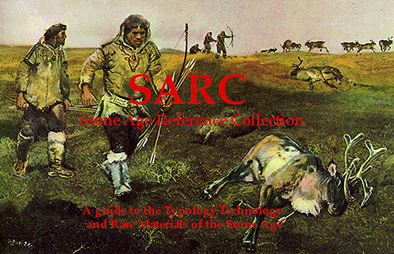Main Page
English page - under construction
The Stone Age Reference Collection (SARC) has been developed for the teaching department of the Institute of Archaeology, History and Conservation (IAKH) at the University of Oslo, Norway.
SARC is a reference program containing information about the typology,technology, raw materials and study methods of the stone age.
It is available in English and Norwegian.
Typology
Main article: Typology.
"Science of classifying stone tools by form, techniques and technological traits. Must include duplication of the technique by first observing the intentional form, then reconstructing or replicating the tool in the exact order of the aboriginal workman. Shows elements of culture. Typology cannot be based on function." (Crabtree 1982:57[1])
Technology
Main article: Technology.
"Technology: The study of techniques. Science of studying and interpreting the combined or distinct attributes of individual techniques. Implies a systematic control of minute and distinguishable detail" (Crabtree 1982:50[1]).
Using the technological approach,
"lithic artifact are no longer exclusively considered as more or less ´characteristic´ objects to be described and classified. Instead these artifacts are also seen as evidence of human behavior in its technical, economic, and even social dimensions. Thus, the technological approach...overcomes...the classic dilemma of "culture versus function" posed by each tool" (Pelegrin 1990:116[2]).
Raw materials
Main article: Raw materials.
Raw materials cover the minerals and rocks that were utilized to produce tools during the Stone Age. These raw materials have certain properties which makes it possible for a toolmaker to control and predict the production of tools by using intentionally chosen methods and techniques. This overview is not complete, but gives a good impression of preferred raw materials in the norwegian Stone Age. The overview seeks to explain why these raw materials were selected for tool production.
Raw material refers to the stone from which debitage, tools etc. are produced. A number of raw materials were used in pre-history, the most common feature of these materials is that they have the property of conchoidal fracture thus enabling the knapper to control the core and produce predictable outcomes of the knapping procedure.
Study methods
Main article: Study methods.
There are various ways of studying and analysing stone tools, including typology, typo-chronology, use-wear analysis, refitting, chaîne opératoire, expert systems, experimental archaeology, and ethnography.
References
List of references and sources of illustrations.
Note on copyright
- ↑ 1.0 1.1 Crabtree, Don E. 1982 An Introduction to Flint working. Occasional Papers of the Idaho Museum of Natural History, Number 28. Second Edition. Pocatello, Idaho.
- ↑ Pelegrin, Jacques 1990 Prehistoric Lithic Technology: Some Aspects of Research. Archaeological Review from Cambridge 9(1).
Pelegrin, Jacques 1990 Prehistoric Lithic Technology: Some Aspects of Research. Archaeological Review from Cambridge 9(1):116-125.
